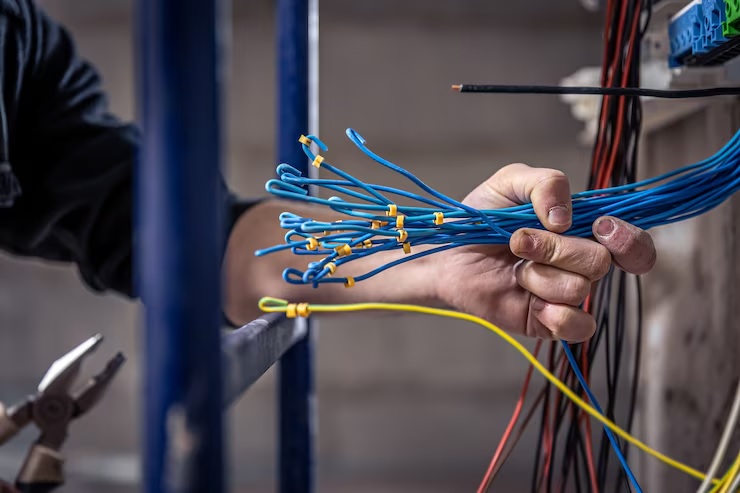Advancements in Biometric Quality Control for Cable Manufacturing

Strong 8k brings an ultra-HD IPTV experience to your living room and your pocket.
When you hear the word "biometrics," things like fingerprint scanners or facial recognition probably spring to mind – technologies used to identify people. But what if we took the core idea – identifying unique, measurable characteristics – and applied it to ensuring the quality of manufactured goods like cables? While we aren't literally taking fingerprints of wires, the principles behind identifying unique patterns and characteristics are inspiring a new generation of advanced quality control (QC) techniques in cable manufacturing, often using sensors that mimic or exceed human senses. Let's explore how this "biometric-inspired" approach is pushing quality standards higher than ever.
What Do We Mean by "Biometric" QC for Cables?
Let's be clear – we're not scanning cable jackets for unique identifiers like fingerprints. Instead, the term here relates to two key concepts:
Advanced Sensing Mimicking Biology: This is the primary focus. It involves using sophisticated sensor technologies (like advanced machine vision, laser scanning, etc.) that act like highly enhanced versions of human senses (especially sight and touch) to detect minute flaws, verify precise dimensions, or identify subtle inconsistencies in cables with accuracy and speed far beyond human capabilities.
Human Operator Verification (A Supporting Role): In certain high-stakes or regulated manufacturing environments, actual biometric authentication (e.g., fingerprint or iris scan) might be used to verify the identity of the trained human operator performing a critical manual inspection step or signing off on a quality check. This adds a layer of accountability and traceability to the human element of QC.
Our main exploration here is the exciting progress in sensor technologies for direct, automated cable inspection.
Limitations of Traditional Visual QC
Skilled human inspectors are invaluable, but even the best face inherent limitations when inspecting potentially kilometers of cable:
Eye Strain and Fatigue: Maintaining focus over long periods is challenging, potentially leading to missed defects.
Subjectivity Factor: One inspector's judgment on a borderline flaw might differ from another's, leading to inconsistency.
Speed Constraints: Manual inspection simply cannot keep pace with modern high-speed extrusion and processing lines.
Hidden Imperfections: Many critical parameters, like microscopic surface defects, slight variations in insulation thickness, or subtle color shifts, are difficult or impossible to spot reliably with the naked eye.
Sampling vs. Continuous: Traditional methods often rely on inspecting samples, whereas automated sensing can potentially check 100% of the cable length.
Advanced, "biometric-inspired" sensing technologies are designed to overcome precisely these challenges.
The Tech Toolkit: Sensing Cable Quality
These automated systems employ various sensors coupled with intelligent software to analyze cable properties objectively:
1. Machine Vision ("Digital Sight")
Industrial Cameras: High-resolution, high-frame-rate cameras capture continuous images of the cable surface from multiple angles under precisely controlled lighting.
AI-Driven Image Analysis: Powerful software algorithms analyze these images instantaneously, comparing them against defined quality standards or 'golden samples'. They excel at detecting:
Surface Imperfections: Scratches, voids, bumps, pinholes, discoloration, contamination.
Dimensional Verification: Continuously measuring diameter and checking for ovality (out-of-roundness).
Print Quality: Ensuring logos, text, and batch codes are present, correct, and clearly legible.
Benefit: Tireless, objective detection of minute visual flaws at high speed.
2. Laser & Optical Gauging ("Precision Touch")
Laser Micrometers: Devices project laser beams across the cable profile. By analyzing how the beams are interrupted, they measure the outer diameter and ovality with extremely high precision without physical contact.
Optical Scanners: Other optical techniques can provide detailed cross-sectional profiles, verifying insulation wall thickness uniformity.
Benefit: Highly accurate, non-contact dimensional measurement along the entire cable length, crucial for ensuring consistent electrical properties and proper fit in connectors.
3. Electrical Integrity Sensing ("Internal Feel")
Inline Capacitance Monitoring: Sensors measure the cable's electrical capacitance continuously during production. Variations can indicate inconsistencies in insulation thickness or material properties that aren't visually apparent.
Spark Testing: A standard test where the cable passes through a high-voltage electrode field. Any pinhole or weak spot in the insulation will cause a spark, instantly detecting breaches invisible to the eye.
Benefit: Identifies critical electrical flaws that could compromise safety or performance.
4. Material Characterization (Advanced Sensing)
Emerging techniques using ultrasound or thermal imaging are being explored to potentially detect variations in material density, composition, or the presence of internal voids within the insulation layers non-destructively.
5. Operator Biometric Authentication (Traceability)
In environments requiring strict process control (e.g., medical or aerospace cables), requiring operators to log their actions using a unique biometric identifier (fingerprint, etc.) before performing manual QC tasks adds an undeniable layer of accountability, linking specific checks to specific individuals. This data can provide end-to-end traceability, potentially connecting back to materials from specific quality cable suppliers in uae.
Why Adopt This Advanced Approach? Key Advantages
Superior Accuracy & Reliability: Sensors detect subtle flaws consistently, surpassing human capabilities.
Comprehensive Inspection: Enables continuous monitoring, potentially inspecting 100% of the product, unlike sample-based checks.
Increased Throughput: Automated inspection keeps pace with high-speed production, preventing QC from becoming a bottleneck.
Objective & Repeatable: Eliminates human subjectivity and ensures consistent application of quality standards.
Rich Data Generation: Creates detailed logs of quality data, invaluable for process optimization, troubleshooting, and traceability.
Reduced Scrap & Rework: Early detection of defects minimizes waste and the cost of fixing problems later.
Implementation Considerations
Investment: Advanced sensor systems, cameras, lighting, and analytical software represent a capital investment.
Calibration & Upkeep: Sensors require periodic calibration and maintenance to maintain accuracy.
Data Handling: Requires robust systems to manage and interpret the large volumes of data generated.
Integration Effort: Integrating these systems seamlessly into existing production lines and control systems needs expertise.
Leading cable manufacturers in uae and globally are increasingly embracing these technologies as part of their commitment to world-class quality and efficiency, vital in competitive markets like India and beyond.
Conclusion: A Sharper Focus on Cable Perfection
While not scanning retinas, the application of advanced sensing technologies inspired by biological perception is fundamentally enhancing how cable quality is assured. Machine vision, laser gauging, and other sophisticated techniques provide a level of scrutiny that is faster, more accurate, and more consistent than ever before. By adopting these "biometric-inspired" QC methods, the cable industry can achieve higher standards of product reliability, reduce waste, optimize processes, and build even greater confidence in the critical connections they manufacture.
Your Biometric QC Questions Answered (FAQs)
So you're not actually fingerprinting the cables?
Correct. The term "biometric-inspired" mainly refers to using advanced sensors (like cameras acting as 'eyes' or lasers as 'touch') to measure unique physical characteristics or detect minute flaws on the cable itself, mimicking how biological systems perceive details.
What's the main difference compared to having a person inspect the cable?
The key differences are accuracy for tiny flaws, speed to keep up with production, consistency (no subjectivity or fatigue), and the potential for 100% inspection rather than just checking samples.
Is this kind of advanced QC technology affordable?
The initial cost for high-end sensors and software can be significant. However, the return on investment often comes from reduced scrap material, fewer customer returns or warranty claims due to defects, and potentially higher production throughput, making it economically viable for many manufacturers focused on high quality.
How does machine vision specifically check cable dimensions?
Vision systems often work in conjunction with precise lighting. By analyzing the silhouette or edges of the cable in the captured images against a calibrated scale, the software can calculate the outer diameter and check for deviations from a perfect circle (ovality) with high accuracy, often from multiple angles simultaneously.
Where does actual human biometric identification fit into this?
In some highly regulated or critical manufacturing processes, actual biometrics (like a fingerprint scan) might be used to log which qualified human operator performed a specific manual inspection, calibration, or batch release, adding a strong layer of personal accountability and traceability to the quality system.
Note: IndiBlogHub features both user-submitted and editorial content. We do not verify third-party contributions. Read our Disclaimer and Privacy Policyfor details.




